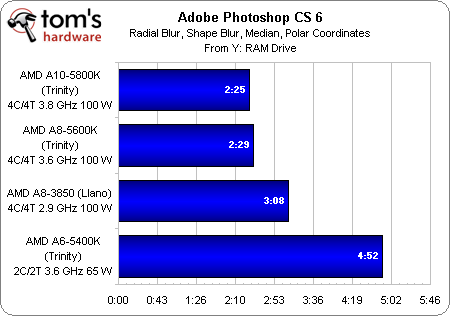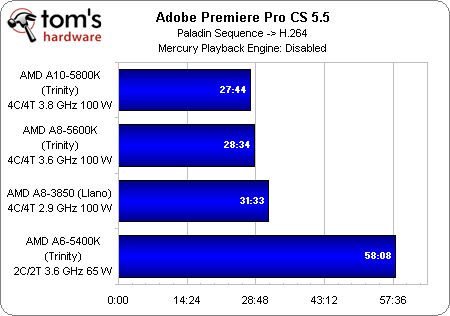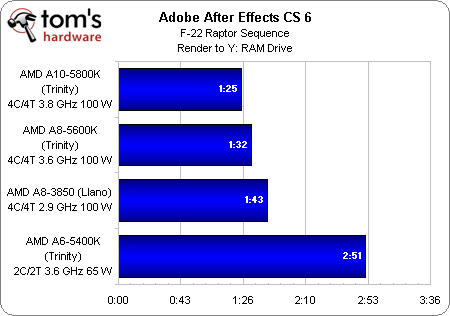AMD Trinity On The Desktop: A10, A8, And A6 Get Benchmarked!
Benchmark Results: Adobe CS5 And 6
Our well-threaded Photoshop CS6 benchmark definitely appreciates the quad-core APUs, favoring two Trinity-based chips over Llano. It’s only when one Piledriver module is stripped from the design that performance plummets.
This is one of those very real-world tests that AMD likes to talk about—applying filters to your work in Photoshop can clearly keep you waiting a while. And if you go the dual-core route, you’ll literally be waiting around twice as long for the task to finish up.
I’d hope that any serious video editor using Premiere Pro already knows the application’s GPU acceleration (enabled via CUDA) is the way to go. If not, though, more CPU cores are the way to go in this threaded app.
Once again we have a very real-world piece of software being used in a very practical way: rendering a finished project. Surely, AMD would agree that the dual-core 65 W APU wasn’t designed for this sort of workload, as it’s simply decimated.
The quad-core APUs do quite a bit better, and the Piledriver architecture easily leverages its clock rate advantage and improved IPC to maneuver around Llano.
But because I already drew one reference to how much better AMD’s integrated Radeon graphics are than Intel’s HD Graphics, I feel it’s equally important to point out Ivy Bridge’s superiority in x86-based workloads. The $210 Core i5-3550 gets this job done in less than half of the time.
Our After Effects workload doesn’t take nearly as long. However, it reflects a similar performance story. Two Trinity-based APU models outmode the A8-3850, while the dual-core A6 trails by a large margin.
Get Tom's Hardware's best news and in-depth reviews, straight to your inbox.
Current page: Benchmark Results: Adobe CS5 And 6
Prev Page Benchmark Results: Sandra 2012 Next Page Benchmark Results: Content Creation-
Youngmind This is so exciting! AMD is probably going to dominate the lower-end and give the poor gamers like me more bang-for-buck as their IGP get better and better :)!Reply -
dudewitbow depending on how its priced, its a really nice alternative for bare budget gaming that opens up a quad core as wellReply -
So this means that a 'Crossfired' Trinity APU would beat ANY similarly-priced Intel (CPU+discrete GPU) ???Reply
Well at least in gaming -
dudewitbow JiggerByteSo this means that a 'Crossfired' Trinity APU would beat ANY similarly-priced Intel (CPU+discrete GPU) ???Well at least in gamingReply
really the question is what gpus are able to hybrid crossfire with it. the information was never public. not all amd gpus will hybrid crossfire with it. -
Well, where are the Ivy/Sandy i5's and i3's???Reply
Once they are pitted against each other, that will be A TRUE measure of the APU Trinity's marketability -
mayankleoboy1 in the OpenCL Winzip benchmark, when openCL is enabled the workload is done only by the iGPU or the CPU as well ?Reply
i mean what is the processor usage during the benchmark ? are all CPU cores used? or only one? -
cangelini mayankleoboy1in the OpenCL Winzip benchmark, when openCL is enabled the workload is done only by the iGPU or the CPU as well ?i mean what is the processor usage during the benchmark ? are all CPU cores used? or only one?Good question--I'll take a look for you.Reply



